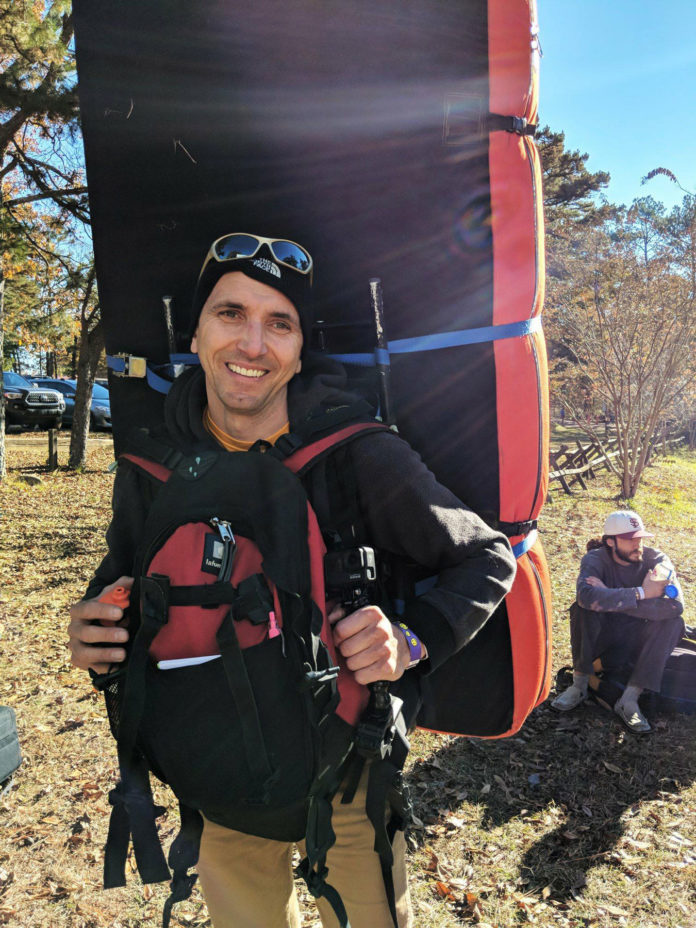Behind the Desk is a series that interviews people who are part of the climbing industry—those who own gyms, run companies, and manage staff. This week, we’re heading south to talk to Adrian Prelipceanu, owner of Active Climbing. Originally from Romania, Prelipceanu relocated to the United States in 2000 and worked within the gym industry in Atlanta for several years before getting inspired to start his own gym. He founded the 6,000-square-foot Active Climbing gym in Athens, Georgia, and years later he founded a second Active Climbing gym—this time much larger (18,000 square feet)—in Augusta, Georgia. But what adds to Prelipceanu’s story is his tireless work ethic. He enjoys—and dabbles in—nearly every aspect of gym construction and operation, and he doesn’t see himself stopping anytime soon.
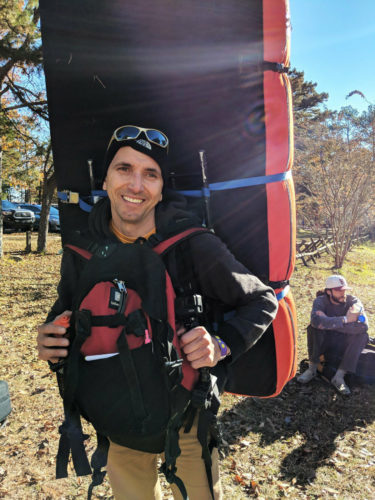
Title: Owner, Active Climbing
Locations: Athens and Augusta, Georgia
CBJ: You lived in Atlanta for a while but, when you decided to start Active back in 2008, you chose to leave Atlanta and go to a much smaller market. Talk about that decision.
PRELIPCEANU: Yes, I chose Athens, Georgia—which was an hour away from Atlanta. It’s a smaller town, a college town, it’s got a slower pace. I loved it. When I first opened the gym, it was rough—when I was trying to buy the property was right when the whole economy was crashing. So, I had a family friend that helped me purchase the property. The building was already there, but I built everything else from scratch. Money was really tight, but somehow I pushed through. I was doing remodeling at the same time too, just trying to bring more money in and keep the gym afloat. But, slowly people in the community, and the college students, were really happy that the town of Athens actually had a climbing gym. Then, in 2015, I was able to open the second Active location—in Augusta, which is 90 miles away from Athens. It’s a bigger city—it’s got about 500,000 people living there. It felt perfect for what I was trying to do. That gym has an elevated stage bouldering section, perfect for big comps, basically like the Adidas Rockstars setup, if people are familiar with that famous competition.
Did opening a second location prove to be easier or harder than you thought it would be?
I think it proved to be complementary, if I can put it that way. Athens is a much smaller location, so with Augusta being a bigger town—and, of course, the revenue is better—the two gyms kind of help each other. And that’s what I had found when I opened a second gym—I drained the finances of my Athens location, and everything I had and didn’t have went into opening the Augusta location. But, slowly, that gym started to give back, and that’s when you feel it’s complimentary. Right now, after almost seven years of having a second location, I’m glad I did it.
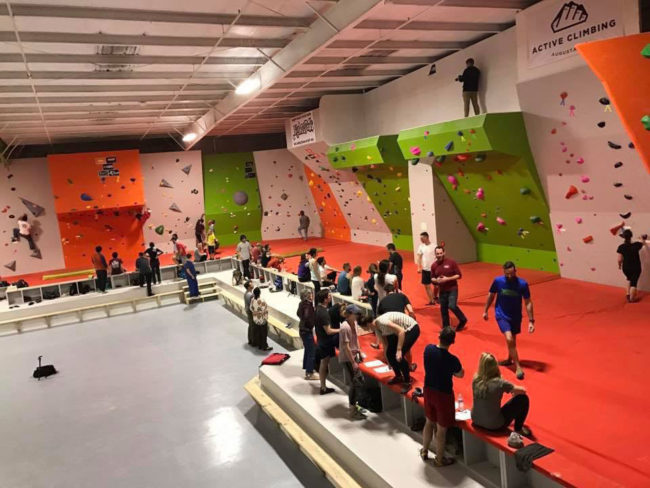
That approach seems a bit unique. I think other gym owners would look at success in a smaller, college-town market and think that any expansion would have to be done in a similar market—another college town, for example—because there was a proven track record of success. Or, conversely, if a gym owner was successful in a big city, they might look to open a second gym in that same city or in another big city. But you had success in a smaller town and then you looked to open a second gym in a big city, a totally different market with totally different dynamics.
Yeah, the concept that I had for my setup was—not everybody likes flashy, commercial, monster gyms. When I first started climbing indoors, here in the United States, it was at Atlanta Rocks, and it was a really tiny gym—I think the [rope] walls were, like, 20 feet high. But the friendships and the community I experienced there, I could not find in the nice, shiny, big locations. You cannot build that. Don’t get me wrong—I’m sure every climbing gym builds their community and starts to form the same feelings that a smaller gym might have. But I always felt that the smaller gyms felt more ‘homey,’ and that was my concept for both gyms—even in the Augusta gym, which was a little bigger.
Let’s talk about the amenities that one might see in really big gyms, or even sometimes in some smaller gyms. For example, your Augusta gym also has a Ninja section. Where do you personally draw the line—meaning, when does a gym achieve amenity-overload, in your opinion?
To me, to answer that question in a general way, many climbing gyms are really trying to broaden their membership base. For example, they know if they include a fitness center, they might get some members who would typically go to an LA Fitness—or whatever. Get those fitness people to join the climbing gym instead of the fitness center. So, I think a lot of climbing gym owners nowadays are trying to tap into a lot of other avenues to bring in more revenue. Neither of my gyms are really like that—yeah, we have a little Ninja set up in Augusta, and we have a few weights, but we can’t have full fitness areas or full treadmill areas, for example, simply because we’ve tried to maximize the space to have more climbing walls.
Where do you draw the line [on amenities]? I don’t know. If I was to open another gym tomorrow, I would probably stay within similar setups that I have right now—mostly climbing, and maybe some complimentary machines and training offerings for the climbers to get stronger. I think there is a correlation between what you offer and what you get to charge the customers. Of course, bigger gyms with bigger budgets can afford to add a lot more elements to try to bring in more members. But do [those elements] really bring in the revenue that the gyms are hoping for? I don’t know because I haven’t been at that level. You can add many elements and bring more people into the gym—and more non-climbers into the gym—but you might lose some of the climbing vibe and the climbing ethic too, and I don’t know if it’s worth it.
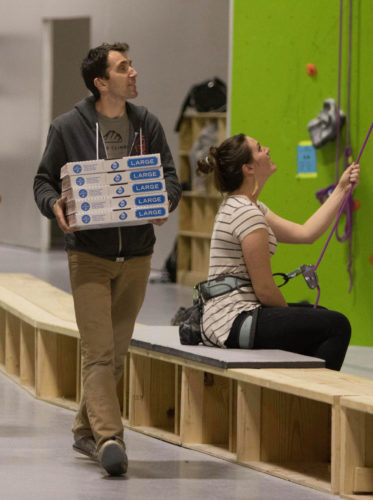
I know that is a goal for some gyms—draw in weightlifters from the nearby LA Fitness, to use your example. Or draw in yogis from the local yoga studio. Or get people to go to the climbing gym’s cafe instead of the Starbucks down the street. But I don’t know if that ends up being the case to any substantial level. I’m not saying it does or it doesn’t—I’m just saying I share your curiosity about it. Put it another way, if all climbing gyms offered only climbing—no extraneous amenities—I wonder if there’d be that big of a drop in gym patronage. I don’t know.
I was joking about this with one of my friends. If you come from the world of smaller climbing gyms and you go to a really big climbing gym, you see all the cardio machines and the fitness center and the weights that the gym has to offer—and you see, maybe, one or two people using them. The rest of the people—sometimes a hundred people or so—will all be climbing. Or, to put it another way, if I hand you my business card and it says that I do electric, plumbing, HVAC…all sorts of stuff…you might hire me because I do all of those, but I’ll probably mainly be good at only one of them. It’s the same with a climbing gym: climbing, yoga, fitness, Ninja, coffee, a retail shop… How many people really use all that? Only the big gym owners and managers could answer the percentages. But five years after a climbing gym has been up and running with all that stuff, I wonder if it’s all worth the investment. I could be totally wrong.
I will say I think it’s based on the demographics—some climbing gyms seem to have those things running really well. I’ve been to some climbing gyms where their ‘coffee center’ was—it was a joy to go; but then there are some climbing gyms’ coffee centers that hardly anyone goes to.
Yes, I’m sure it’s a case-by-case basis. It will be interesting to see if the climbing gym industry continues arching towards more and more amenities, which definitely feels like the direction we’ve been going for a while.
Yeah, the way my mind works, and the way I grew up, is: If I buy something, do I use it, or did I just buy it because I wanted it? The trend for more amenities started somewhere, some climbing gym, and I think other climbing gyms saw it as successful and tried to copy it: Well, they have a big fitness area, so now we’re going to have to have a big fitness area too! I think that’s how it started. Like you said, it might change in the years to come, but for right now, a lot of gyms that I’ve been to, I don’t see justification of some space; I see a lot of spaces in climbing gyms collecting dust.
Aside from owning gyms, you also own your own flooring company. How’d that come about?
It started because I built my Athens gym and I needed pads. I called some companies—whoever did gym flooring at that point—but the prices were astronomical for my income. I just could not afford it. So, I bought a sewing machine at Walmart, I bought some fabric, and started making pads for myself and others. Over the last 12 years I’ve improved quite a bit since the first one. I made a pad for a gym I built in Chattanooga last year…the pad is 1,500 square feet, all just one piece. I’m trying to go for the Guinness World Record.
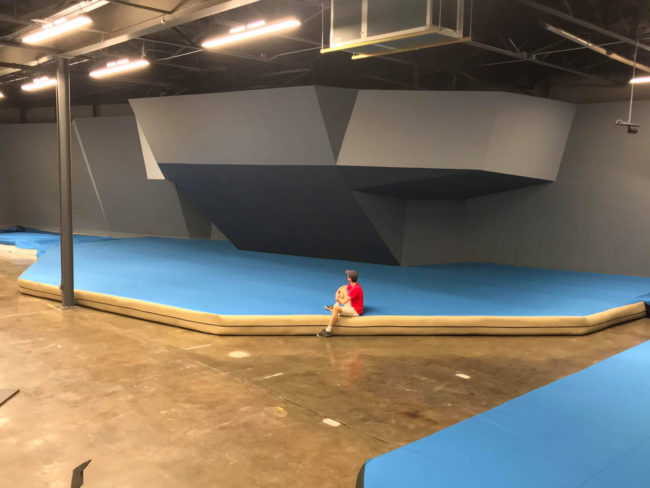
Tell me more about this pursuit of the Guinness World Record!
Well, I’m still trying to figure out how to apply for that, the Guinness World Record. It will be for ‘the largest crash pad ever built.’ The pad is basically the size of a house, at 1,500 square feet. It was quite a challenge to sew all that fabric, its shape, even more challenging to install it. But it is one of its kind and I’m proud of it.
So, the pads are just—I wear quite a few hats, and the pads venture, it’s just another hat. Building climbing walls for others is another hat too. My wife says I’m cursed because I never stop working, and I think she’s right [laughs].
On that note, in terms of your constant work, what have been the keys to success?
Set your goals and don’t stop until you get there. If it was easy, everyone would have done it.
For gym expansion, in particular, I think every town can hold a climbing gym—no matter the size of the town. My philosophy is to build smaller gyms because I think the way smaller gyms are run and feel, the finances, they’re a lot more manageable for a regular person…unless you have a lot of money, in which case you can go to a really big city and try to put up a climbing gym. But climbing has become mainstream enough now that any place over 50,000 or 60,000 people—you can put a climbing gym there.
I wonder if we’ll see trends to smaller gyms in much smaller markets in the coming years.
I am pretty sure because a lot of people—especially nowadays—don’t want to go into big crowds. So, I think the trend will start to go where people want to know the people they are with. Let’s say you join a climbing gym and you know how the people behave, react, and so forth—you might want to join that place before you join a bigger place with a big crowd of people you don’t know. These smaller towns will bring that—the smaller community will be happy to have a place like that. That’s how it was when I started the gym in Athens, and that’s how it still is. That’s what I have learned from the very first gym I ever climbed at: climbing is social; it’s not just who is the strongest. The really big climbing gyms will continue to open —they’ll never stop opening. But it might slow down, and I think the smaller gyms will pop up all over the place. I just hope we can get more folks exposed to climbing, regardless of the size of the gym, or if the climbing is outdoors. I hope everyone can be safe and enjoy it.

John Burgman is the author of High Drama, a book that chronicles the history of American competition climbing. He is a Fulbright journalism grant recipient and a former magazine editor. He holds a master’s degree from New York University and bachelor’s degree from Miami University. In addition to writing, he coaches a youth bouldering team. Follow him on Twitter @John_Burgman and Instagram @jbclimbs. Read our interview Meet John Burgman, U.S. Comp Climbing’s Top Journalist.




